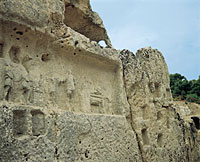
dal 1996 in continua innovazione tecnologica!
Sfrutta tecnologie avanzate per avere un sito web ottimizzato al 100%

Akrai Archaeological Area on the Acromon Hill
The
city of Akrai, located west of the modern Palazzolo Akreide, the oldest
of the sub-colonies of Syracuse, according to Tucicide, founded 70
years after the foundation of the motherland, is located in the
westernmost part of the plateau between the two Tellaro valleys to the south and to the north of Aapo and occupied a strategic place that allowed the control of the hinterland.
Early studies on the ancient city date back to the 16th century. XVI and concerned the identification of the site of the ancient city. The first to identify Akrai with the site west of Palazzolo was the Fazello, but it is only with Baron Judica in the sec. XIX which begins its true archaeological research.
The
most recent research on the site of the ancient city made it possible
to highlight a road axis (EW), with EW orientation, which was the most
important road axis connecting the two gates of the city (Siracusana and
selinuntina). Of this, a section of about 250 m has been revealed; has a width of 4.00 m. and a late-Hellenic lava stone pavement. That axis was intercepted by transverse roads (stenopoi), wide m. Approximately 3.00. It has been highlighted 2 south and 5 north of the road. The pavement of these seems to be restricted to the cross sections only. These
stenopos cross the plain obliquely and the ones located to the north
are offset and not aligned with those located to the south. The urban layout seems to have had three building phases: archaic, Hellenistic and Roman age. To the west, the auditorium ended in a paved square, while on the east
side was the theater scene that was then inserted into the urban
layout.
The theater was discovered in 1824 by G. Judica. He
has to dig the scene, the orchestra, the lower steps of the cavea, but
also restoration and reconstruction of the cavea until the twelfth step.
The study and research was then started by L. Bernabò Brea. All in all, this is a rather small building with the cavea, largely
made in the slope of the hill, semi-circular like the orchestra.
It had nine wedges originally separated by eight steps, but only the two at the ends were entirely built. Rebuilt
up to the 12th step should not have more than 14. There were no
parodies and access came from two narrow steps on the sides of the
scene. Of this, one recognizes a remake of an imperial age, consisting of a pulpitum placed on a part of the scene. This monument was chronologically framed in the Ionian age (3rd century BC) as the nearby bouleuterion.
The Bouleuterion, located southwest of the theater, was excavated in 1820 by Judica. It consists of a quadrangular environment, with cavea consisting of six steps of steps, divided into three wedges. It was preceded by a porch on the agora.
On
the hill overlooking south the theater is an archaic temple (probably
the second half of the 6th century BC), located at the highest point of
the city, identified with the temple of Aphrodite mentioned in an
inscription. Based on the studies conducted, it has a cell with adyton and a pronaos in front; had a peristasis of 6x13, with a second row of columns on the forehead.
To the east of the theater are the latomies of the Engraved and the Intagliatella. These are stone quarries, transformed by Christian and Byzantine ages into sepulchres and dwellings. The carpenter, which has a "I" development, had also on the front of
the latom of the recesses that housed tablets or pinks, with scenes
related to the cult of heroes.
source region sicily cultural heritage
